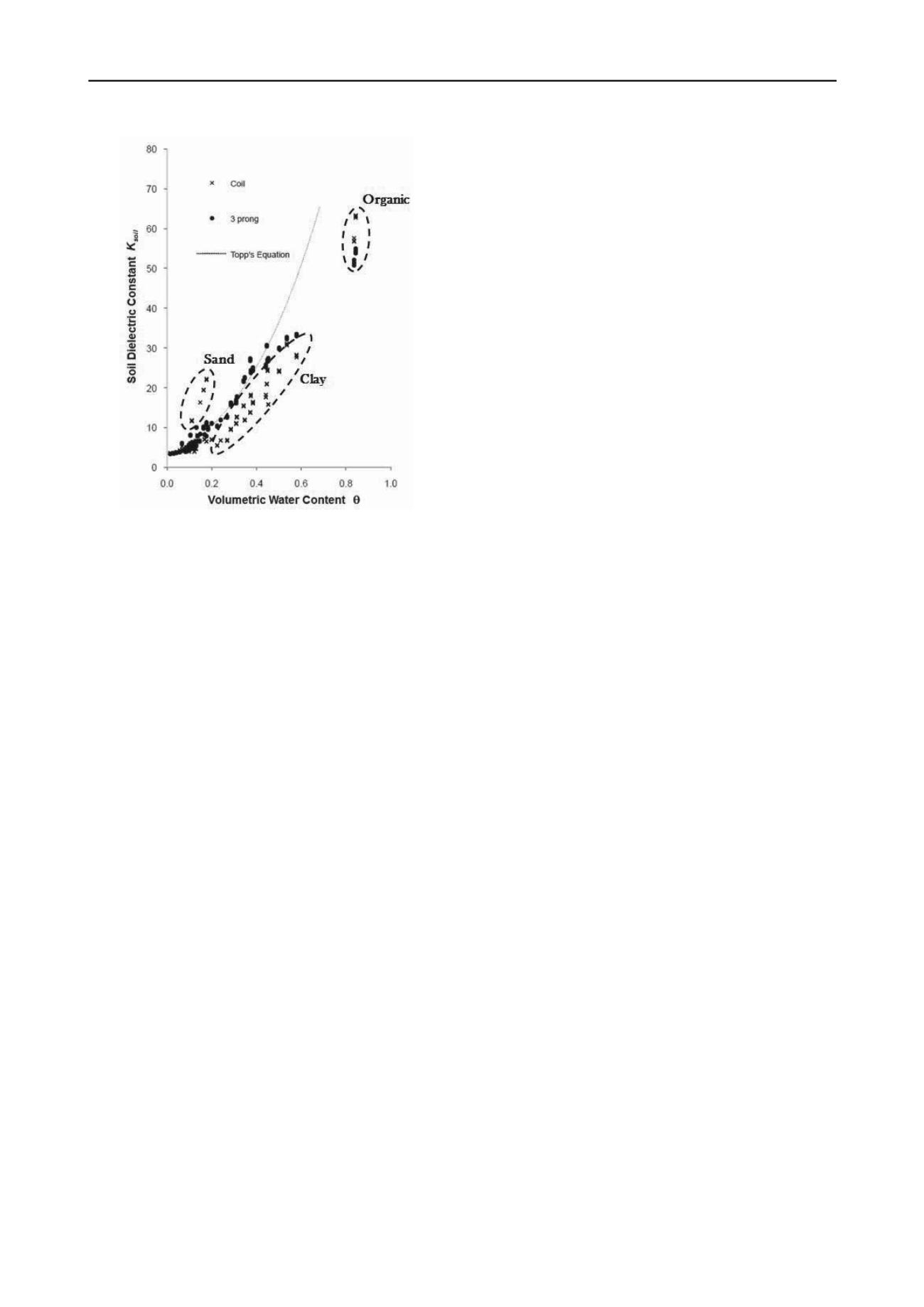
1202
Proceedings of the 18
th
International Conference on Soil Mechanics and Geotechnical Engineering, Paris 2013
Figure 5. Comparison between the Coiled TDR (with a steel tensiometer
housing) and a conventional 3 prong TDR device for Leighton Buzzard
sand, Birtley Clay and a very loose organic soil.
neglected, a different optimal value of
K
house
would be achieved
that would provide a closer fit to the observed values.
Ignoring the anomalous results for sand and comparing
calculated and measured water contents it was found that the
ceramic probe gave an accuracy for water content determination
of ±0.047. This resulted in an
R
2
value of 0.966 for
K
soil
when
compared to the actual
K
a
found from known
θ
. Likewise for
the stainless steel probe, accuracy was found to be ±0.075 with
an
R
2
value of 0.937. Improved accuracies can be obtained from
direct calibration, rather than applying a mixing model.
It can be seen that Topp’s equation does not provide a good
fit to the results (from either device) for the very loose organic
soil. It is known that Topp’s equation is not appropriate for high
volumetric water contents (>0.5).
4 CONCLUSIONS
The design and laboratory testing of new devices for water
content measurement are described. A flexible multi-electrode
resistivity system has been developed to acquire resistivity data
using different arrays, including a resistivity probe. The novel
coiled TDR device uses a two-pronged TDR wrapped around
the body of the Durham University high capacity tensiometer.
The devices have been developed to carry out experimental
studies to monitor water content changes in unsaturated soil
specimens submitted to drying and wetting cycles.
5 REFERENCES
Asquith, J.D., Toll, D.G. and Johnson, K.L., 2012. Design and
Construction of Large Lysimeters for Monitoring Unsaturated
Transport of Contaminants, in Unsaturated Soils: Research and
Applications 2: 2nd European Conference on Unsaturated Soils.
Naples, Italy (eds. Mancuso, C., Jommi, C. & D’Onza F.), Springer,
447-453.
ASTM G57. 2006. Standard test method for field measurement of soil
resistivity using the Wenner four-electrode method, American
Society for Testing and Materials.
Bryson, L. S., 2005. Evaluation of geotechnical parameters using
electrical resistivity measurements.
Proc.
Earthquake Engineering
and Soil Dynamics
, GSP 133, Geo-Frontiers 2005, ASCE, Reston,
VA. 1-12.
Calamita, G. Brocca, L.. Perrone, A Piscitelli, S. Lapenna, V. Melone,
F. and Moramarco, T., 2012. Electrical resistivity and TDR
methods for soil moisture estimation in central Italy test-sites,
Journal of Hydrology
, 454/455, 101-112.
Damasceno V.M., Fratta D. and Bosscher P.J., 2009. Development and
validation of a low-cost electrical resistivity tomographer for soil
process monitoring.
Canadian Geotechnical Journal,
46, 842–854.
Ferré, P.A., Knight, J.H., Rudolph, D.L. and Kachanoski, R.G., 1998,
The sample areas of conventional and alternative time domain
reflectometry probes. Water Resources Research, 34, 2971-2979.
Fukue, M., Minatoa, T., Horibe, H., and Taya, N., 1999. The
microstructure of clay given by resistivity measurements.
Engineering Geology,
54, 43–53.
Habberjam, G.M., and Watkins, G.E., 1967. The use of a square
conguration in resistivity prospecting.
Geophys. Prospec
., 15,
445–467.
Knight, J.H., 1992, Sensitivity of time domain reflectometry
measurements to lateral variations in soil water conent.
Water
Resources Research
, 28, 2345-2352.
LaBrecque, D., and Daily, W., 2008, Assessment of measurement errors
for galvanic-resistivity electrodes of different composition:
Geophysics
, 73, F55 – F64.
Loke, M.H., 2011. Electrical imaging surveys for environmental and
engineering studies.
Lourenço, S., Gallipoli, D., Toll, D. and Evans, F., 2006. Development
of a commercial tensiometer for triaxial testing of unsaturated soils.
Proc. of the 4th International Conference on Unsaturated Soils,
Phoenix, USA, ASCE, Geotechnical Special Publication No. 14,
Vol. 2, 1875–1886.
McCarter, W.J. 1984. The electrical resistivity characteristics of
compacted clays.
Geotechnique
, (34), 263–267.
Mendes, J., 2011. Assessment of the impact of climate change on an
instrumented embankment: an unsaturated soil mechanics
approach, PhD thesis, Durham University. Available online:
/
Michot, D., Benderitter, Y., Dorigny, A., Nicoullaud, B., King, D.,
and Tabbagh, A., 2003, Spatial and temporal monitoring of soil
water content with an irrigated corn crop cover using surface
electrical resistivity tomography,
Water Resour. Res
., 39(5), 1138.
Muñoz-Castelblanco, J.A., Pereira, J.M., Delage, P. and Cui, Y.-J.,
2011. The Influence of Changes in Water Content on the Electrical
Resistivity of a Natural Unsaturated Loess.
Geotechnical Testing
Journal
35 (1), 11-17.
Noborio, K., 2001, Measurement of soil water content and electrical
conductivity by time domain reflectometry: a review.
Computers
and Electronics in Agriculture
, 31, 213-237
Pozdnyakov, A., Pozdnyakova, L., and Karpachevskii, L. 2006.
Relationship between water tension and electrical resistivity in
soils.
Eurasian Soil Sci
. 39 (1), 78-83.
Robinson, D. A., Campbell, C. S., Hopmans, J. W., Hornbuckle, B. K.,
Jones, S. B., Knight, R., Ogden, F., Selker, J. and Wendroth, O.,
2008. Soil moisture measurement for ecological and hydrological
watershed scale observatories: A review,
Vadose Zone J.,
7, 358 –
389.
Roth, K., Schulin, R., Flühler, H. and Attinger, W., 1990. Calibration of
time domain reflectometry for water content measurement using a
composite dielectric approach.
Water Resources Research
, 26,
2267-2273.
Russell, E.J.F. and Barker, R.D., 2010. Electrical properties of clay in
relation to moisture loss,
Near Surface Geophysics,
8, 173-180.
Shah, P.H. and Singh, D.N., 2005. Generalized Archie’s Law for
estimation of soil electrical conductivity.
J. of ASTM Inter
., 2
(5), 1–20
Tarantino, A., Ridey, A.M. and Toll, D.G., 2008. Field measurement of
suction, water content and water permeability.
Geotechnical and
Geological Engineering
, 26, 751-782
Topp, G.C., Davis, J.L., and Annan, A.P., 1980. Electromagnetic
determination of soil water content: measurements in coaxial
transmission lines.
Water Resources. Research
. 16 (3), 574–582
Vereecken, H., Huisman, J. A, Bogena, H., Vanderborght, J., Vrugt, J.
A. and Hopmans, J.W., 2008. On the value of soil moisture
measurements in Vadose Zone hydrology: A review,
Water
Resources Research
, 44, W00D06.
Zhou, Q.Y., Shimada, J. and Sato, A., 2001. Three-dimensional spatial
and temporal monitoring of soil water content using electrical
resistivity tomography.
Water Resources Research
, 37, 273–285.


